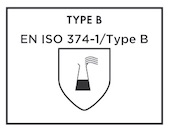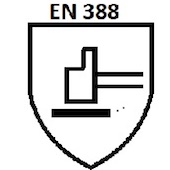1. What is it for?
Hand protection is designed to guard against a wide range of hazards, including:
- cuts and abrasions;
- extreme temperatures;
- skin irritation and dermatitis; and
- contact with toxic or corrosive substances.
Different types of protection are available, depending on the likely hazards. The most obvious form are gloves, which can be made from a wide range of materials. Barrier creams are also a type of hand protection and can be used as an aid to skin hygiene.
Remember: barrier creams do not offer good protection against skin irritation and dermatitis, which can be caused by contact with oils and other chemicals. They must not be used instead of gloves, but as a supplement to them. To be effective, they should be applied to clean hands, over the wrist onto the lower arm, before gloves are put on.2. What types are available?
| Type of glove | Application |
| Latex disposable | Standard examination gloves |
| Non-latex (medical) disposable, e.g. nitrile | Examination of unknown chemicals, drugs, staining of the skin, contagious diseases (e.g. hepatitis) |
| PVC gloves | Handling with diesel and other fuel oils, some common chemicals |
| Rubber moulded gauntlets/industrial gloves (suitable for rummaging aircraft WCs, engine rooms, etc.) | Protection against excrement, disinfectant and household chemicals, diesel and other fuel oils |
| Cotton gloves with leather palms (suitable for cargo examination and rummaging work) | Protection against splinters, abrasions and minor cuts (e.g. from rough or sharp edges) |
| Heavy duty leather and Aramid | Protection against cuts and abrasions (sharp objects) |
| Nylon gloves (for boarding vessels, etc.) | Non-slip palms afford good grip and limited hand protection |
Warning: Gloves must be stored appropriately and replaced regularly. Both natural and artificial rubbers decompose over time and may not provide the correct level of protection.
For sampling purposes your exposure to a chemical should be short – but it is important to understand the risks and the capabilities of the gloves. The following terms are usually used:
- Permeation – the process where the chemical travels through the glove at a molecular level. The permeation rate indicates how long the glove can be worn. A glove with a low permeation rate is best.
- Penetration – the bulk flow of chemical through pinholes, seams or other faults in the glove.
- Degradation – the damaging change in one or more physical properties of the protective glove as a result of exposure to a chemical.
- Breakthrough Time – the time between the first contact with the glove and detection of the chemical inside the glove. This is stated on the chemical compatibility chart. The breakthrough time of a chemical resistant glove should be more than 30 minutes.
Finally, it is important to avoid inadvertent exposure to the chemical when removing the gloves.
Gloves designed for protection against chemicals must comply with the standard EN374, which provides different levels of cover:
| Basic protection: Waterproof and protection against biological contamination |
Type A: Protective glove with permeation resistance of at least 30 minutes each for at least 6 test chemicals |
Type B: Protective glove with permeation resistance of at least 30 minutes each for at least 3 test chemicals. |
Type C: Protective glove with permeation resistance of at least 10 minutes for at least 1 test chemical. |
 |
 |
 |
 |
You should check that the glove provides appropriate protection for the chemical concerned and adequate time for sampling to be carried completed.
There are several other standards which give markings for different types of protection:
| EN 388 Mechanical protection against abrasion and cuts |
EN 407 Fire/Heat Protection |
EN 511 Cold/Frost Protection |
EN 16350 Electrostatic Protection |
 |
 |
 |
(No marking specified) |
3. Where must hand protection be worn?
You must wear hand protection wherever there is a risk of any kind of injury or disease in the course of the work being carried out.
Wherever it is compulsory to wear hand protection on a trader’s premises, a sign similar to that shown
here will normally be displayed. In most cases this will mean gloves, except where there is a danger of them being caught in machinery or if it is important to retain some flexibility of movement.
Disposable gloves should be worn in combination with other PPE when officers handle with dangerous goods or the chemicals with unknown composition as well as infectious agents, blood and body fluids.
Additional layers of gloves may be necessary to provide greater protection or protection against a combination of chemical/biological and physical risks.
4. What are its limitations?
PVC gloves should not be worn in very low temperatures because they can become stiff.
Heavy leather or cotton gloves can become uncomfortable if worn for long periods, particularly in a warm environment.
Gloves offer no protection to the wrists or forearms. If there is a risk of damage to these parts of the body, gauntlets should be worn and tucked into the sleeves of other clothing. This reduces the risk of spillages down the arm and into the glove area.
When handling chemicals exposure must be kept to a minimum. Even though the SDS may recommend gloves these may only protect you for a limited time. The chemical may degrade or permeate the glove after even quite a short amount of time. If you are uncertain, seek advice or use trained staff or contractors to carry out the sampling.
5. How do I look after it?
You can keep most gloves in good condition by cleaning and storing them in accordance with the manufacturer’s instructions. The following specific instructions will prolong the life of certain gloves:
- PVC gloves should be kept clean by washing the outer surfaces regularly — if you allow them to get dirty they will be far less effective.
- Natural rubber (latex) gloves are easily damaged. Do not let them come into contact with oils, grease, turpentine or other solvents. You should also:
- wash them with soap and water if they have been used for handling strong acids or alkalis;
- store them in a strong container, in a cool dry place, when not in use;
- make sure your hands are clean and dry before putting them on;
- wash the insides regularly with soap and water — and allow them to dry thoroughly; and
- not wear them for longer than absolutely necessary.
Disposable gloves are used for single operation and once used; they should be disposed of — but remember that they will probably need to be treated as hazardous waste. Especially when handling with dangerous goods, chemicals with unknown composition as well as infectious agents, special care must be taken when they are removed to avoid the secondary contamination.
You must place any contaminated gloves in a separate tightly closed bag to be removed by an approved waste disposal company.
The attention should be also paid to correct putting on and removal of gloves to avoid the cross contamination.
You must refer to the legislation and the guidance of your national administration for more information.







